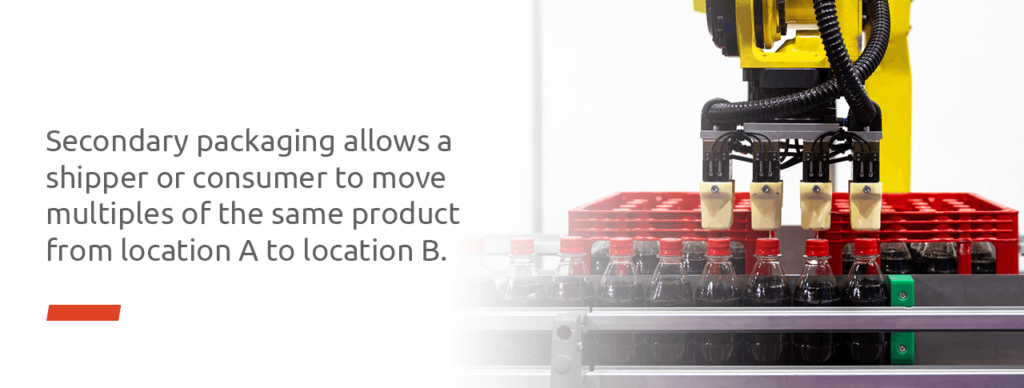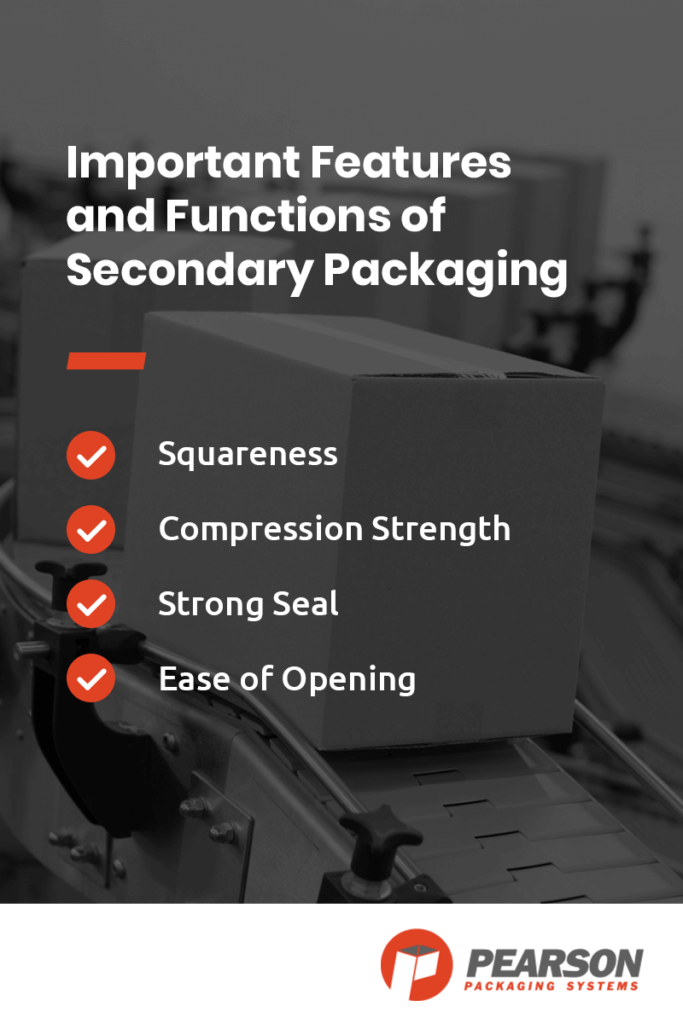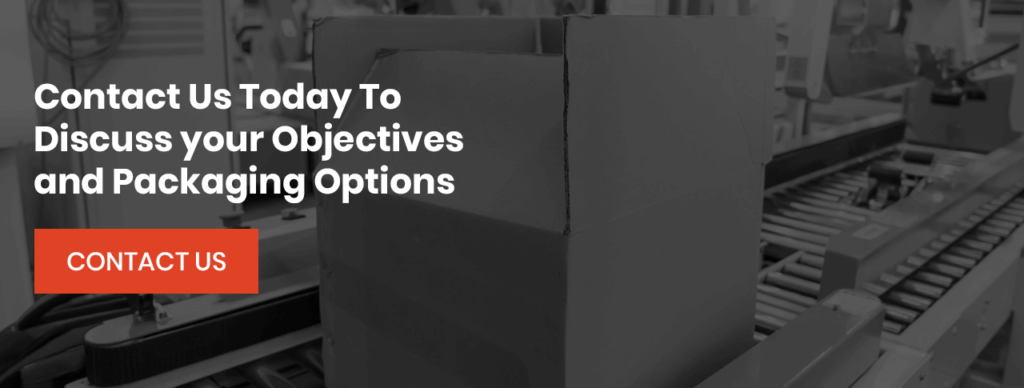Packaging identifies the product within, bundles multiple items together, protects them from damage during transit and shipping, and makes it easier for consumers to transport the product from store to home. Packaging is usually layered, with each layer providing a unique function. The layers are commonly referred to as primary, secondary and sometimes tertiary packaging, although the use of these terms or alternatives is often inconsistent. In this article, we will take a closer look at secondary packaging and the benefits of automating this process.
- What Is Secondary Packaging?
- Types of Secondary Packaging
- Corrugated Packaging
- Components of a Secondary Packaging System Using Corrugated Cases
- Benefits of Automating the Secondary Packaging Process
- How Pearson Can Help Automate Secondary Packaging Processes
What Is Secondary Packaging?
While primary packaging is in direct contact with the product to contain, protect, preserve and identify it, secondary packaging adds the next layer. As such, secondary packaging often adds additional protection and marketing opportunity such as a carton around a bag of cereal. It is also designed to hold together multiple units of a product such as a 12-pack box of soda cans or multiple trays of a macaroni and cheese dinner. This allows the product to be effectively transported to a retailer or warehouse. Secondary packaging must also protect the products within during transportation and distribution. It keeps aluminum cans from getting dented and crackers from being crushed, but it also prevents fading or other damage to the branding and logos that might be on the primary packaging. The stacking of shipping containers onto a pallet is sometimes referred to as tertiary packaging but since its function is the same as secondary packaging, in that it bundles units for efficient transport and distribution, we will wrap it into the category of secondary packaging for the purpose of this discussion.
Secondary packaging plays a big role during the manufacturing and distribution of a product. You might have heard it referred to by a different name, such as overwrapping, outer packaging or end-of-line packaging. All these names refer to the same thing: packaging that facilitates the efficient and safe distribution of a product from one location to the next.

Types of Secondary Packaging
There are three main types of secondary packaging, each with unique benefits and drawbacks, depending on how it is used.
- Chipboard cartons: Chipboard is a type of cardboard. It consists of layers of paper glued together. Chipboard is available in various thicknesses, and its strength and durability vary based on its thickness. Chipboard can cost less than other secondary packaging options, but it also tends to be less strong and resilient compared to other options, such as corrugated cardboard. A common example is a cereal box or a carton filled with tea bags.
- Corrugated cases: Corrugated cases are also made from cardboard, but the construction of the cardboard is different from that of chipboard. Corrugated cases feature a fluted sheet of paper between two layers of paperboard. The fluted sheet makes the walls of a corrugated case strong and durable. Corrugated cases can handle being stacked and roughly handled during transportation, making them particularly suitable for shipping containers.
- Heat/shrink wrap: Heat or shrink-wrap is a type of polymer film that surrounds a good. The film is wrapped around a selection of products, such as a case of water bottles. Heat is directed at the film, which causes it to contract and shrink, securely holding the products together. This type of secondary packaging is generally more cost-effective but increases the burden at the retail location if the package needs to be opened and placed on the shelf.
Which particular type of secondary packaging you choose depends largely on the application. However, in the following paragraphs, we will take a closer look at corrugated packaging.
Corrugated Packaging
Corrugated packaging containers are available in various different designs. Although the terminology is standardized by the Fibre Box Association, many simply refer to the various styles as a box. The following list describes the most common box types, all of which can be handled by Pearson Packaging’s automated packaging equipment.
- RSC or Regular Slotted Containers: A regular slotted container has flaps on the top and bottom. Two of the flaps on each side are half of the width of the container. They meet in the center and allow the box to close.
- HSC or Half-Slotted Containers: A half-slotted container only has flaps on the bottom. The top of the box is open.
- FOL or Full Overlap Slotted Container: The flaps are fully overlapping as they close.
- CSSC or Center Special Slotted Container: This style is also referred to as ‘all flaps meet’ since the four flaps meet in the middle as they are closed.
- Bliss boxes: Bliss boxes consist of several pieces, including a body and side panels. The pieces are glued together, creating a container that is particularly strong and durable.
- Partition inserts: Partition inserts slip into the case or bliss box, dividing up space within so products don’t move or shift during transportation.
Components of a Secondary Packaging System Using Corrugated Cases
Since the secondary packaging line is usually the last part of the manufacturing process before the product can be loaded onto the truck, it is also often called end-of-line packaging. A secondary packaging system, manual or automated, consists of the following components:

- Building the box: Before a box can be filled, it has to be built. An important aspect of the building or erecting process is that the case needs to have square corners with right angles. If the box is skewed or uneven, it will not seal properly. It’s also difficult to stack skewed boxes.
- Packing the box: Boxes can be packed using top loading, bottom loading or end loading methods. While manual operations generally top load, it is also the ideal loading technique for packing semi-rigid or flexible products, such as bags and pouches. When you’re deciding how to pack cases or how much product to put into a case, consider the size of the box in relation to the size of the product. When the case is notably larger than the product that fills it, the product could move in transit, becoming damaged. A box that is on the small side can be overfilled or might be challenging to fill consistently during an automated process.
- Sealing the box: Sealing the box or case involves folding down the flaps and securing them in place with either glue or tape. Ideally, the seal on the case will be strong enough to last through the transport and shipping process but easy enough for a person in a retail outlet to open, in some cases without a knife. In any case, a person should be able to open the case without damaging the product inside. When deciding on the best way to seal a case, the speed of your line or concerns about contamination particles may influence the decision for tape or glue.
- Palletizing: After the cases are built, filled and sealed, they need to be stacked onto pallets for easy and efficient transport. When preparing to palletize packaging, you need to consider the stacking strength of the cases. Are the boxes strong enough to support the product within? Some boxes have a higher stacking strength than others. Another thing to consider is the pallet pattern you use. How the cases are arranged on the pallet determines its stability. There are also ways to arrange cases on a pallet to make the best use of space.
While building, packing, sealing and palletizing are the primary components of a secondary packaging system, there are a number of ancillary components to consider, such as sorting and labeling, check-weighing and metal detection for quality control, and wrapping of pallets.
Benefits of Automating the Secondary Packaging Process
In the earlier days of a business, workers may have easily kept up with the secondary packaging process, building boxes, filling them, sealing them, then preparing them for palletization. As demand grows, relying on manual labor not only limits further growth but also adds risk in terms of potential injuries or insufficient access to labor to meet daily production goals. Automating the packaging process allows you to prepare shipments more quickly without having to hire more people. There are several notable benefits of automation.
- Increases throughput rates: Automated packaging machinery can operate much more quickly than a person can, effectively increasing production throughput when you switch to automation. Increasing production speed enables you to sell more products and keep up with market demand.
- Reduces costs: Automated packaging machinery can help your company save money. Considering continuously rising minimum wages and the shortage of labor leading to increasing costs of hiring, training and injury prevention, automation of previously manual packaging operations often have a surprisingly fast return on your investment. Even accounting for the cost of maintaining equipment, it often is more affordable over time to automate than it is to keep adding to your staff.
- Improves employee well-being: Factory assembly line work can cause repetitive motion injuries. When you use machinery to build, pack, seal and palletize boxes, you free your staff up to handle other tasks, reducing their risk of injuries and helping them feel more engaged with their work. When your team feels more excited about the work they’re doing, your company is likely to see a boost in productivity.
- Ensures consistency and quality: Automated machinery is generally more accurate and consistent than humans, elevating your quality and brand perception, while reducing loss from damage or poor appearance.

How Pearson Can Help Automate Secondary Packaging Processes
Pearson is a packaging company with more than 65 years of industry experience and more than three decades of robotic integration experience producing and providing machines that can handle 24/7 uptime and high-volume operations. We will work with you to streamline your secondary packaging process, allowing you to maximize efficiency and expand your business. Our secondary packaging equipment includes case erectors, bliss formers, case packers, bag inserters, partition inserters, case sealers and palletizers.
We also offer machine upgrades and modifications to keep your equipment running for as long as possible and to customize it to meet your needs better. For example, we offer the option of upgrading to glue stitching for bliss former machines or installing a tape assist device to keep under-filled cases from collapsing. Pearson’s field-service technicians, field-service engineers and factory technicians are available to perform routine maintenance, troubleshooting and servicing to keep your secondary packaging equipment up and running. You can count on Pearson for quality, durable packaging automation equipment and for technical service to keep it operating at its best and for the lowest cost possible.
Contact Us Today to Discuss Your Objectives and Packaging Options
Our teams of packaging system designers and application engineers will work closely with you to create an integrated system that best meets your packaging needs. To learn more, contact us today.

